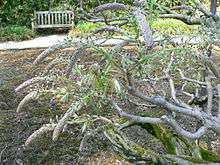Wisteria floribunda
| Japanese wisteria | |
|---|---|
 | |
| Scientific classification | |
| Kingdom: | Plantae |
| (unranked): | Angiosperms |
| (unranked): | Eudicots |
| (unranked): | Rosids |
| Order: | Fabales |
| Family: | Fabaceae |
| Subfamily: | Faboideae |
| Genus: | Wisteria |
| Species: | W. floribunda |
| Binomial name | |
| Wisteria floribunda (Willd.) DC. | |


Wisteria floribunda (common name Japanese wisteria) is a species of flowering plant in the pea family Fabaceae, native to Japan. Growing to 9 m (30 ft), it is a woody, deciduous twining climber. It was brought from Japan to the United States in 1830's.[1][2] Since then, it has become one of the most highly romanticized flowering garden plants. It is also a common subject for bonsai, along with Wisteria sinensis (Chinese wisteria).
The flowering habit of Japanese wisteria is perhaps the most spectacular of the Wisteria family. It sports the longest flower racemes of any wisteria; they can reach nearly half a meter in length. These racemes burst into great trails of clustered white, pink, violet, or blue flowers in early- to mid-spring. The flowers carry a distinctive fragrance similar to that of grapes. The early flowering time of Japanese wisteria can cause problems in temperate climates, where early frosts can destroy the coming years' flowers. It will also flower only after passing from juvenile to adult stage, a transition that may take many years just like its cousin Chinese wisteria.
Japanese wisteria can grow over 30m long over many supports via powerful clockwise-twining stems. The foliage consists of shiny, dark-green, pinnately compound leaves 10–30 cm in length. The leaves bear 9-13 oblong leaflets that are each 2–6 cm long. It also bears numerous poisonous, brown, velvety, bean-like seed pods 5–10 cm long that mature in summer and persist until winter. Japanese wisteria prefers moist soils and full sun in USDA plant hardiness zones 5-9.[3] The plant often lives over fifty years.
Wisteria floribunda cultivars
Those marked agm have gained the Royal Horticultural Society's Award of Garden Merit.
- 'Shiro Noda', 'Snow Showers' or 'Longissima Alba' agm[4] - long white flower clusters
- 'Kuchibeni' or 'Carnea' - pink flowers
- 'Honbeni' or 'Rosea'agm[5] - pale rose flowers tipped purple, 18 inches long
- 'Issai Perfect' - light lavender flowers
- 'Jako' or 'Ivory Tower'
- 'Lawrence' - blue flowers, hardy cultivar
- 'Macrobotrys' or 'Longissima' - reddish-violet flower clusters one meter or longer
- 'Macrobotrys Cascade' - white and pinkish-purple flowers, vigorous grower
- 'Multijuga'agm[6] - violet flowers with darker markings
- 'Nana Richins Purple' - purple flowers
- 'Nishiki' - variegated foliage
- 'Plena' or 'Violaceae Plena' - double blue flowers in dense clusters
- 'Praecox' or 'Domino' - purple flowers
- 'Purpurea' - unknown - May be Wisteria sinensis consequa which is sometimes labeled purpurea
- 'Royal Purple' - purple flowers
- 'Rubra'- unknown - may be Honbeni - sometimes labeled as Rubrum - deep pink to red flowers
- 'Texas Purple' - may be a sinensis or a hybrid, short racemes, purple flowers, produced while the plant is still young
- 'Violacea Plena' - double violet flowers, rosette-shaped
- 'White with Blue Eye' - also known as Sekines Blue - very fragrant
External links
| Wikimedia Commons has media related to Wisteria floribunda. |
- Japanese Wisteria at MSU
- Japanese Wisteria as a pest
- University of Ohio fact sheet for Wisteria family
References
- ↑ "Wisteria floribunda, W. sinensis". United States Forest Service. Retrieved December 12, 2014.
- ↑ "Japanese Wisteria". National Park Service. Retrieved December 12, 2014.
- ↑ Growth Conditions
- ↑ "RHS Plant Selector - Wisteria floribunda 'Alba'". Retrieved 9 June 2013.
- ↑ "RHS Plant Selector - Wisteria floribunda 'Rosea'". Retrieved 9 June 2013.
- ↑ "RHS Plant Selector - Wisteria floribunda 'Multijuga'". Retrieved 9 June 2013.